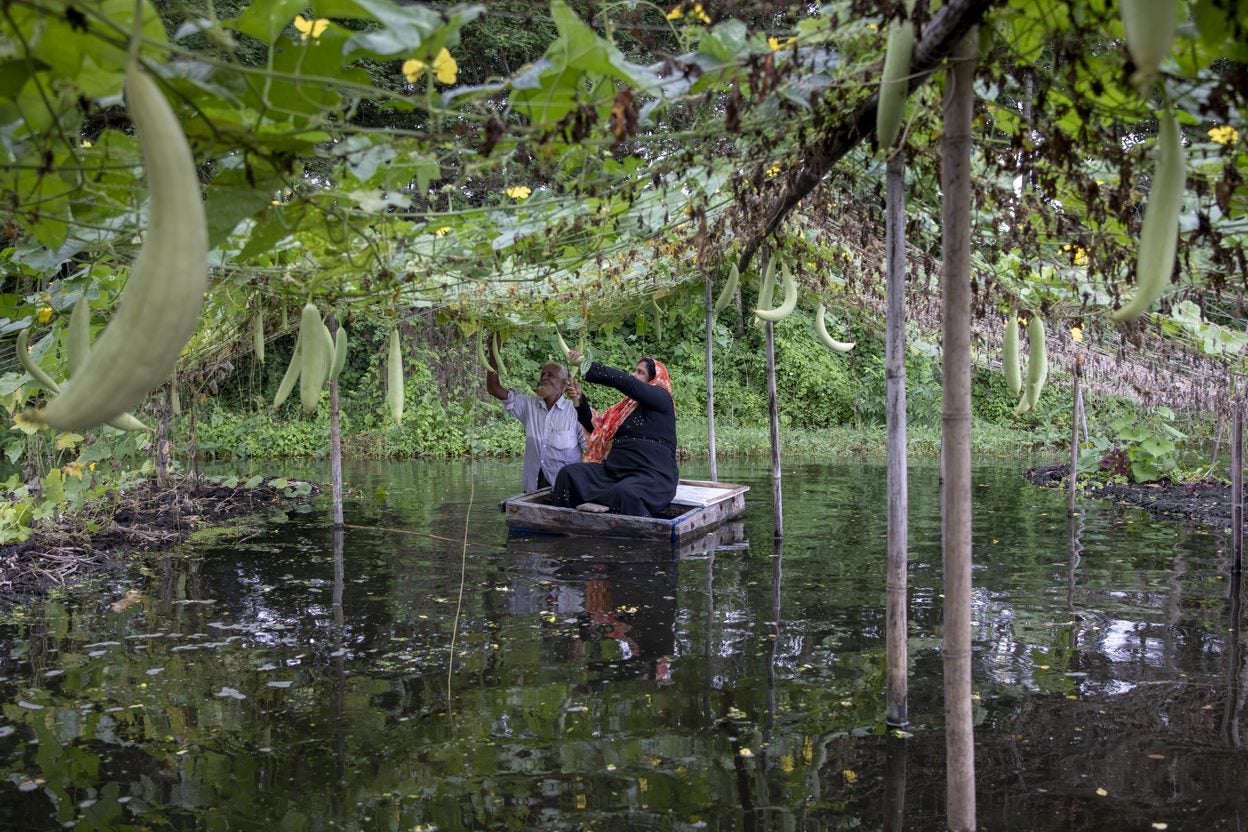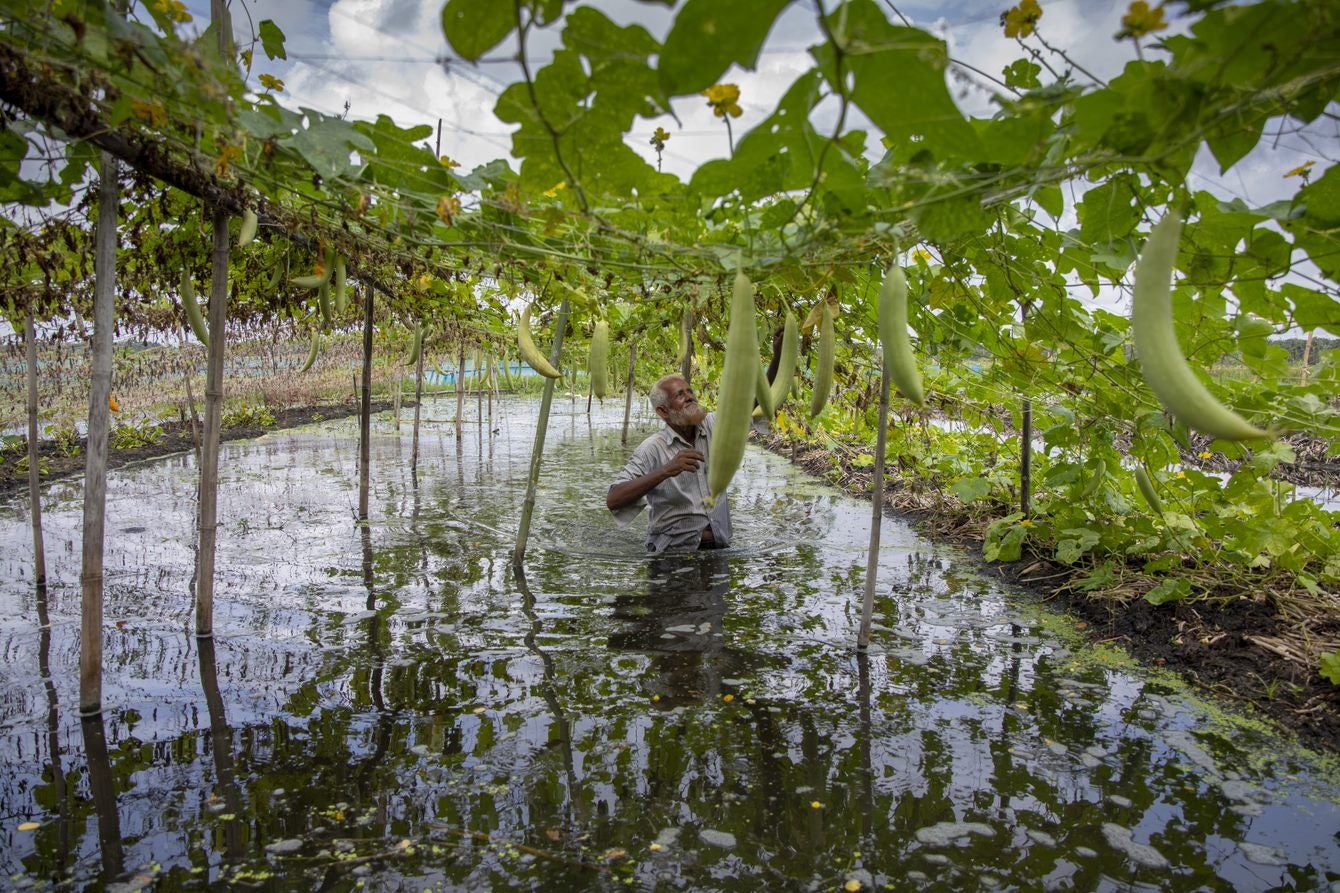 Farmers practicing floating bed agriculture in Barisal, Bangladesh.
Farmers practicing floating bed agriculture in Barisal, Bangladesh.
Sitting comfortably in an airplane, the various rivers crisscrossing the Barisal region in southern Bangladesh offer a beautiful sight to behold.
For locals, however, these rivers are both a blessing and a curse.
This causes waterlogging and disrupts traditional farming practices, hampering crop production.
Also, inadequate research about these climate-constrained areas, compounded by low usage of new technologies, has stalled agricultural productivity.
Barisal and its neighboring districts are highly prone to climate hazards, like extreme flooding and rising salinity in soil and water.
But farmers in several districts of Bangladesh have found ways to fight back against climate change.
To that end, the National Agriculture Technology Program (NATP 2), a World Bank-supported project, which aims to improve productivity and food security, has helped farmers adopt new farming practices more resilient to climate change.
Fifty-seven districts have implemented the project, targeting smallholder farmers, who make up 80 percent of the country’s rural population.
NATP 2 also introduced agricultural innovation funds for researchers, farmers, and rural agro-entrepreneurs to help integrate new technologies into farming for a more diversified agriculture and better access to markets.

This past September, we visited Bagerhat district to witness some of this innovative work.
We met farmers living in wetlands who are suffering from an almost yearlong water congestion caused by faulty drainage, which has severely restricted the amount of land they can farm.
One such practice called floating bed agriculture consists of building agriculture beds with water hyacinth and other plants.
Sheikh Abdul Hamid has been farming most of his life and started investing in floating beds about five years ago.
Farmers have adopted a 200-year-old agriculture practice which has given them hope not merely to survive but thrive...
Thanks to a loan and guidance from the Social Development Foundation, a not-for-profit organization set up by the government, and by Department of Agricultural Extension, he created several floating beds that now generate a handsome monthly income.
Sheikh Abdul Hamid now grows a variety of crops such as cucumber, gourds, tomatoes, eggplants, and many more. His success has encouraged his neighbors to invest in floating beds and produce a similar variety of produce.
Altogether, NATP 2 is working with over 1 million smallholders, of whom more than a third are women, and has established 30 commodity and marketing centers which have sold 6,137 tons of produce thus far.
Back to our site visit.
We hopped on an open trawler and navigated the Madhumati river – getting drenched in the rain – to reach Pakuria, a remote village of Nazirpur Upazilla.
Here, the vast expanse of floating beds was a treat for sore eyes.

We met Bipul Mondal, a carpenter by day and farmer by night. He is a proud owner of 24 floating beds and expects to get a bumper crop by the end of the harvest season in October.
“Without the guidance of the local team, I would have been unaware of the crops to grow on the floating beds and how to best construct them,” he said.
NATP 2 has made it a priority to train farmers and teach them skills during on-farm demonstrations. The project seeks to increase yields by 14 to 100 percent for a few commodities.
The program is working with over 1 million smallholders, a third of whom are women...
In Tarabunia village in Nazirpur Upazilla, we observed the “Sorjan” farming practice, which consists of raising the soil and creating deep trenches. The ‘raised beds’ lie at a level above the reach of tidal surges and are thus protected from any natural calamities. The trenches serve as pools to farm fish and ducks.
Suravi Boral, 30, has been using Sorjan to farm mangoes, litchi, malta, and plums. She and her husband, Monmoto Edbor, have been exclusively growing fruits on the Sorjans, which yield bumper crops and get a better price than Taman and boro crops in the markets.
Without training and new technology support, this would have been only a dream, they say.
However, as the project draws to a close, several challenges remain.
Adopting innovative, sustainable, and inclusive agriculture practices will be critical to the development of Bangladesh.
First, connectivity to markets remains a challenge for farmers located in remote regions as the quality of fresh produce deteriorates before reaching consumers.
Second, while access to financing through loans is easily available, poor farmers often shy away from them for fear of incurring debt.
Adopting innovative, sustainable, and inclusive agriculture practices will be critical to the development of Bangladesh.


Join the Conversation